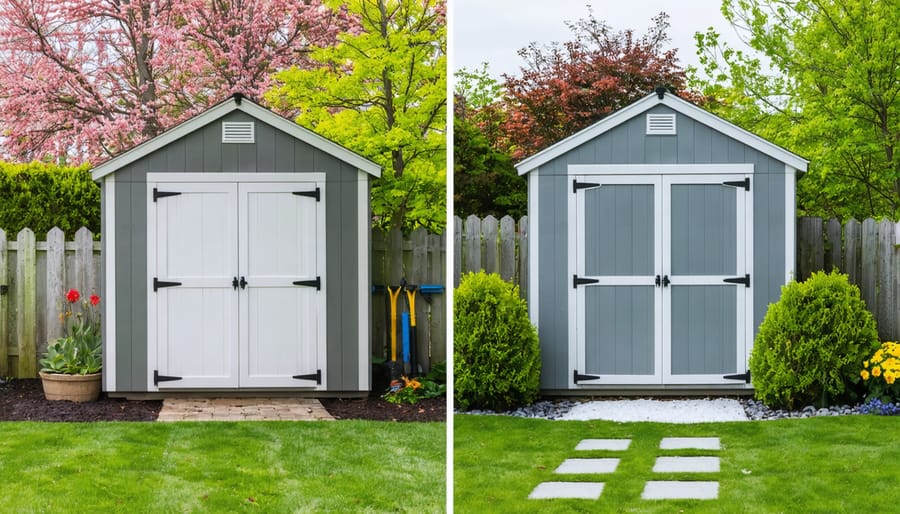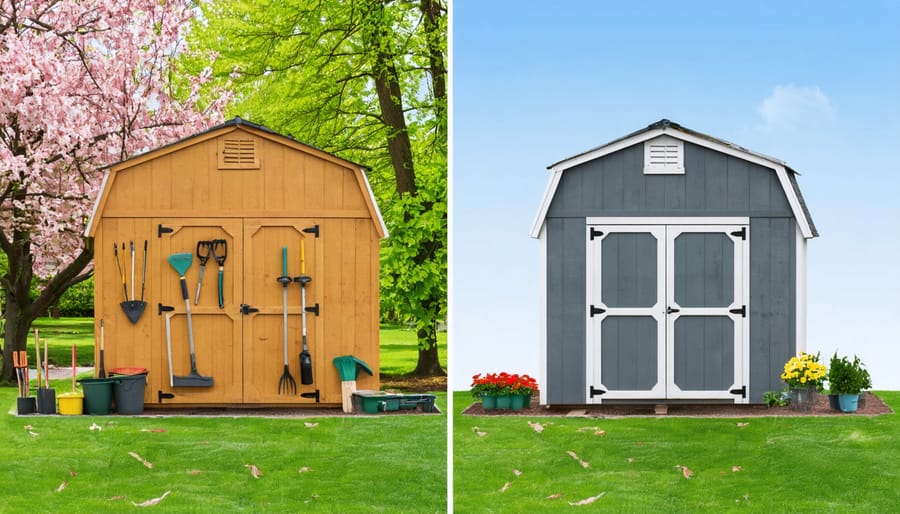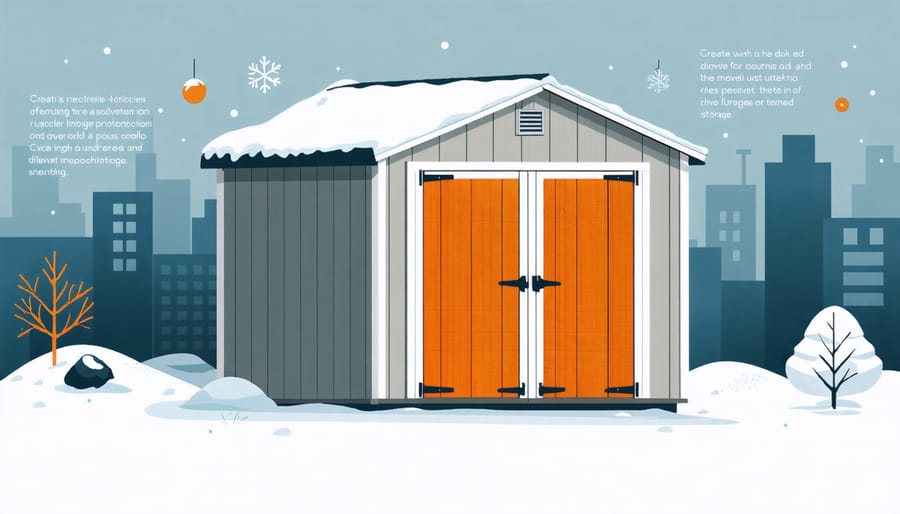Keep Your Shed Perfect Year-Round: Simple Seasonal Maintenance That Works

Transform your yard into a year-round showcase with strategic seasonal maintenance that prevents costly repairs and enhances curb appeal. Each season demands specific attention – from spring’s awakening tasks to winter’s protective measures – creating a continuous cycle of care that keeps your outdoor space thriving.
Spring calls for thorough debris removal and equipment preparation, while summer focuses on consistent mowing patterns and strategic watering schedules. Fall requires methodical leaf management and soil preparation, and winter demands protective covering for sensitive plants and proper snow removal techniques. This systematic approach to yard maintenance not only preserves your property’s value but also creates an inviting outdoor environment that can be enjoyed throughout the year.
Whether you’re a seasoned gardener or new to home maintenance, understanding these seasonal rhythms helps you work smarter, not harder. By tackling specific tasks at optimal times, you’ll prevent common problems before they start and maintain a yard that neighbors admire year-round. Let’s explore the essential maintenance tasks that keep your outdoor space beautiful and functional through every season.
Spring Shed Care: Preparing for Growing Season
Post-Winter Inspection and Repairs
As winter’s grip loosens, it’s crucial to assess your yard for any damage the cold season may have left behind. Start by walking your property to identify broken branches, damaged fencing, or areas where frost heave has affected your hardscaping. Look for signs of erosion around your shed’s foundation and check that drainage paths haven’t been altered by winter storms or snow accumulation.
Pay special attention to your lawn, noting any areas affected by snow mold or winter kill. These patches will need immediate attention to prevent weed invasion and ensure healthy grass growth. Inspect trees and shrubs for broken limbs or split bark, addressing these issues promptly to prevent further damage and promote healing.
Check your irrigation system for any damage from freezing temperatures. Run a test cycle to identify possible leaks or broken sprinkler heads. This is also the perfect time to clean out your gutters and downspouts, ensuring proper drainage when spring rains arrive.
Don’t forget to examine outdoor furniture and decorative elements. Clean or repair items as needed, and consider refinishing or waterproofing wooden pieces that show signs of weather wear. Replace any damaged landscape lighting fixtures and verify that all electrical connections are secure and protected from moisture.
Remember to document any significant damage for insurance purposes, especially if winter storms have caused substantial issues requiring professional repair.

Spring Cleaning and Organization
As winter fades away, spring presents the perfect opportunity to refresh and organize your workspace effectively. Start by removing everything from your shed and giving it a thorough inspection. Check for any water damage, loose boards, or signs of pest intrusion that might have occurred during winter.
Clean all surfaces with a mild detergent solution, paying special attention to corners and shelving units. Remove cobwebs, dust, and debris that have accumulated over the winter months. Don’t forget to sweep the floor thoroughly and check for any moisture issues that need addressing.
This is also the ideal time to sort through your tools and equipment. Create three piles: keep, donate, and dispose. Clean and oil your garden tools to prevent rust, and replace any worn-out items. Consider implementing a zone system for your shed, grouping similar items together – gardening tools in one area, power equipment in another, and seasonal items in easily accessible spots.
Install pegboards or wall-mounted organizers to maximize vertical space and keep tools off the floor. Label storage containers clearly and consider using clear bins for better visibility. Don’t forget to check your shed’s ventilation system and clean any vents or windows to ensure proper airflow throughout the warmer months ahead.
Finally, create an inventory list of your shed’s contents and take photos of your newly organized space. This will help maintain the organization system throughout the year and make future spring cleanings more manageable.
Summer Maintenance: Protection and Accessibility
Heat and Sun Protection
Summer heat can take a toll on your storage shed and its contents, but with proper protection, you can maintain a safer environment for your belongings. Managing shed temperature during hot months is crucial for preserving both the structure and your stored items.
Start by installing proper ventilation through roof vents or small solar-powered fans to promote air circulation. Consider adding reflective insulation or radiant barrier material to the roof and walls, which can significantly reduce heat absorption. This simple addition can lower interior temperatures by up to 10-15 degrees.
Protect windows with UV-resistant films or install exterior awnings to block direct sunlight. For door protection, weather stripping helps maintain cooler temperatures while keeping dust and humidity at bay. Consider painting your shed’s exterior in light colors to reflect sunlight rather than absorb it.
For sensitive items, create elevated storage solutions to keep them off the potentially hot floor. Use moisture-absorbing products to control humidity levels, and consider adding a small battery-operated temperature monitor to track conditions inside your shed.
Remember to check stored chemicals and paint, as extreme heat can affect their stability. Move temperature-sensitive items to climate-controlled spaces during peak summer months, and ensure any electronic equipment is properly protected from heat exposure.

Yard Management Around Your Shed
Maintaining the area around your shed is crucial during peak growing season to prevent damage and keep your storage space easily accessible. Start by establishing a clear perimeter of at least 2-3 feet around your shed, removing any weeds, tall grass, or invasive plants that could trap moisture against the structure.
Regular mowing and trimming around the shed help prevent pests from making homes near your storage area and reduce the risk of moisture-related issues. Consider laying down gravel or mulch in this buffer zone to minimize weed growth and improve drainage around the foundation.
Keep tree branches and shrubs trimmed back to prevent them from scratching or damaging your shed’s exterior. Falling leaves and debris can accumulate in gutters and around the base of your shed, so regular cleanup is essential, especially during fall.
For areas where grass meets the shed’s walls, use a string trimmer carefully to avoid damaging the siding. Installing landscape edging can create a clean boundary and make maintenance easier throughout the growing season.
Pay special attention to drainage patterns around your shed during rainy periods. Grade the soil to slope away from the structure, preventing water from pooling near the foundation. This simple step can significantly extend your shed’s lifespan and protect stored items from moisture damage.
Fall Preparation: Getting Ready for Winter
Weather-Proofing Tasks
As winter approaches, weatherproofing your shed becomes essential to protect both the structure and its contents. Start by inspecting the roof for any loose shingles or damage that could lead to leaks. Replace worn weather stripping around doors and windows, and apply fresh caulk to seal any gaps where moisture might seep in.
Check your gutters and downspouts, clearing them of leaves and debris to ensure proper water drainage. Installing gutter guards can help prevent future clogs and reduce maintenance needs. Don’t forget to examine the foundation area – proper grading around your shed will direct water away from the structure.
Inside the shed, invest in moisture-absorbing products or a small dehumidifier to keep the air dry. Consider adding insulation to walls and ceiling if you store temperature-sensitive items. Place valuable tools and equipment on shelves or pallets to protect them from potential ground moisture.
Remember to trim back any overhanging branches that could damage your shed during storms. Apply a fresh coat of weather-resistant paint or sealant to exposed wood surfaces, paying special attention to trim and door frames. These simple preventive measures will help extend your shed’s life and protect your belongings through the harsh winter months.
Fall Clean-Up and Organization
As temperatures drop and leaves begin to fall, it’s time to transition your yard from summer to fall mode. Start by thoroughly cleaning and inspecting your summer gardening tools before storage. Remove any dirt, rust, or debris, and apply a light coat of oil to metal surfaces to prevent corrosion during winter storage.
Create designated zones in your storage area for different categories of items. Group summer furniture cushions together, ensuring they’re clean and completely dry before storing them in waterproof containers or heavy-duty bags. For garden tools, install a pegboard system or use wall-mounted tool holders to keep everything organized and easily accessible.
Pool equipment requires special attention before storage. Drain and clean all items thoroughly, and store chemicals in a temperature-controlled area away from direct sunlight. Consider using clear, labeled storage bins for smaller items like pool toys and maintenance supplies.
Don’t forget about your lawn care equipment. Empty fuel from gas-powered tools or add a fuel stabilizer if recommended by the manufacturer. Clean or replace air filters, and ensure all equipment is properly serviced before storage. Store batteries from electric tools in a cool, dry place, and keep them partially charged during the off-season.
Finally, create an inventory list of stored items and their locations. This will make spring setup much easier and help you identify any maintenance needs during winter storage.
Winter Watch: Protecting Your Investment

Snow and Ice Management
Winter brings unique challenges for shed maintenance, with snow and ice posing potential risks to your structure. Regular snow removal from your shed’s roof is essential to prevent excessive weight buildup, which can cause structural damage. Use a roof rake with an extended handle to safely clear snow while keeping your feet firmly on the ground.
Pay special attention to ice dam formation along your shed’s roofline. These frozen barriers can trap melting snow, leading to water seepage and interior damage. Installing heat cables along the roof edges before winter sets in can help prevent ice dam formation.
Keep pathways to your shed clear of snow and ice to maintain safe access throughout winter. Spread pet-friendly ice melt products around your shed’s entrance and along frequently used paths. Avoid using rock salt directly near your shed, as it can damage the foundation and surrounding vegetation.
Check your shed’s gutters and downspouts regularly during winter thaws. Ensure they remain clear of ice buildup to properly channel water away from your structure. If you notice icicles forming, this could indicate poor insulation or ventilation issues that need addressing.
Consider installing snow guards on metal roofs to prevent dangerous snow slides. For wooden sheds, inspect the roof regularly for signs of stress or sagging under snow weight. Remember, prevention and prompt attention to winter-related issues will help maintain your shed’s integrity throughout the cold season.
Winter Storage Solutions
Proper winter storage is crucial for protecting your valuable yard equipment and maintaining an organized outdoor space during the cold months. Start by thoroughly cleaning and drying all tools and equipment before storage – this prevents rust and deterioration. Following these winter tool storage tips will help extend the life of your gardening implements and power tools.
Create designated zones within your storage space for different categories of items. Keep frequently used winter tools like snow shovels and ice melt near the entrance for easy access. Store summer equipment like lawnmowers and trimmers toward the back after proper winterization. Consider installing wall-mounted storage solutions to maximize vertical space and keep items off the ground.
Moisture is your biggest enemy during winter storage. Install a small dehumidifier or use moisture-absorbing products to maintain optimal humidity levels. Weather stripping around doors and windows helps prevent drafts and moisture infiltration. For additional protection, cover sensitive equipment with breathable tarps rather than plastic, which can trap moisture and promote rust.
Don’t forget to organize smaller items in clear, labeled containers. This makes it easier to find what you need without having to search through multiple boxes. Keep any temperature-sensitive liquids, paints, or chemicals in a climate-controlled space, as extreme cold can affect their effectiveness and container integrity.
Regular seasonal yard maintenance isn’t just about keeping up appearances – it’s an investment in your property’s longevity and functionality. By following a structured maintenance schedule throughout the year, you can prevent costly repairs, extend the life of your outdoor structures, and maintain a beautiful, functional yard space.
Remember to tackle spring cleanup with enthusiasm, removing winter debris and preparing your yard for new growth. Summer maintenance focuses on managing growth and protecting your outdoor spaces from intense heat and sun exposure. Fall preparation is crucial for winterizing your property and managing leaf cleanup, while winter maintenance ensures your yard and structures stay safe and protected during harsh weather.
The key to successful yard maintenance lies in consistency and proactive care. Keep tools organized and readily available, maintain a calendar of seasonal tasks, and address small issues before they become major problems. Don’t forget to adjust your maintenance routine based on your specific climate and property needs.
Regular maintenance not only preserves your yard’s appearance but also enhances your property’s value. A well-maintained yard creates an inviting outdoor space for family activities and entertainment while protecting your investment in outdoor structures and landscaping. By staying on top of seasonal maintenance tasks, you’ll enjoy a beautiful, functional yard space throughout the year while avoiding costly repairs and replacements down the line.

